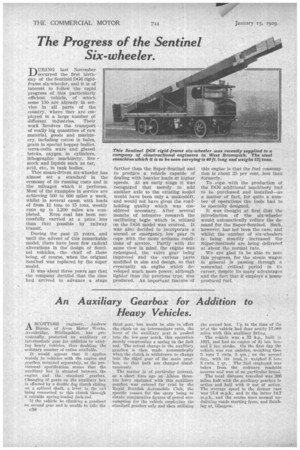The Progress of the Sentinel Six-wheeler.
Page 22

If you've noticed an error in this article please click here to report it so we can fix it.
TNURING last November JJ occurred the first birthday of the Sentinel DOG rigidframe six-wheeler, and it is of interest to follow the rapid progress of this particularly efficient vehicle, of which some 150 are already in service in all parts of the country; where they are employed in a large number of different industries. Their work involves the transport of really big quantities of raw material, goods and machinery, including cotton in bales. grain in speciat hopper bodies, terra-cotta ware and glazed bricks, oxygen in cylinders, lithographic machinery, live stock and liquids such as tar, acid, etc., in tank bodies.
This steam-driven six-wheeler has almost set a standard in the economy of its running costs and in the mileages which • it performs. Most of the examples in service are achieving 500 to 600 miles a week, whilst in. several cases, with loads of from, 12 tons to 15 tons, weekly runs up to 1,200 miles are com pleted. Even coal has been successfully carried at a price less than that possible by railway transit. •
During the past 25 years, and until the advent of this remarkable model, there have been few radical alterations in the design of Sentinel vehicles, the chief of these being, of course, when the original Sentinel was replaced by the super model.
It was about three years ago that the company decided that the time bad arrived to advance a ..stage farther than the Super-Sentinel, and to produce a vehicle capable of dealing with heavier loads at higher Speeds. At an early stage it was recognized that merely to add another axle to the existing model would have been only a makeshift, and would not have given the roadholding quality which was considered necessary. After several months of intensive research the oscillating bogie which is utilized on the DOG model was evolved. It was also decided to incorporate a second or emergency. low gear to cope with the more arduous conditions of service. Partly -with the same view in mind, the engine was redesigned, the valve 'gear being improved and the various parts modified in size and design, so that eventually an engine which developed much more power, although lighter than the previous • type, Was produced. An important feature of
this engine is that the fuel consumption is about 25 per cent. less than formerly.
To cope with the production of the DOG additional machinery had to be purchased and installed—as a matter of fact, for quite a number of operations the tools had to be specially designed.
It was thought at first that the introduction of the six-wheeler would automatically reduce the demand for the Super-Sentinel. Such, however, has not been the case, and whilst the -number of six-wheelers is being steadily increased the Super-Sentinel S are being delivered at about the normal rate.
We are glad to .be able to note this , progress, for the steam wagon in general is passing through a somewhat critiCal perhid • in its career; despite. its many advantages and the fact that it einploys a homeproduced fuel.
































